Research Process: Analysis of Fatal Building Construction Accidents
VerifiedAdded on 2023/06/10
|6
|1823
|283
Report
AI Summary
This report reviews a paper titled "Analysis of Fatal Building Construction Accidents: Cases and Causes," published in the Journal of Multidisciplinary Engineering Science and Technology (JMEST). The paper examines data collected from September 2015 to October 2016 by the Department of Safety and Health (DOSH) in Malaysia, focusing on 30 fatal cases over 14 months. The analysis identifies falling from height as the most common cause of death, with lack of compliance and improper use of protective equipment as leading factors. The report further discusses literature review importance, qualitative and quantitative data analysis, and alternative research strategies like descriptive, analytical, fundamental, and predictive research. It concludes by suggesting initial research ideas to improve safety measures in developing countries by studying past injuries and implementing dedicated solutions.
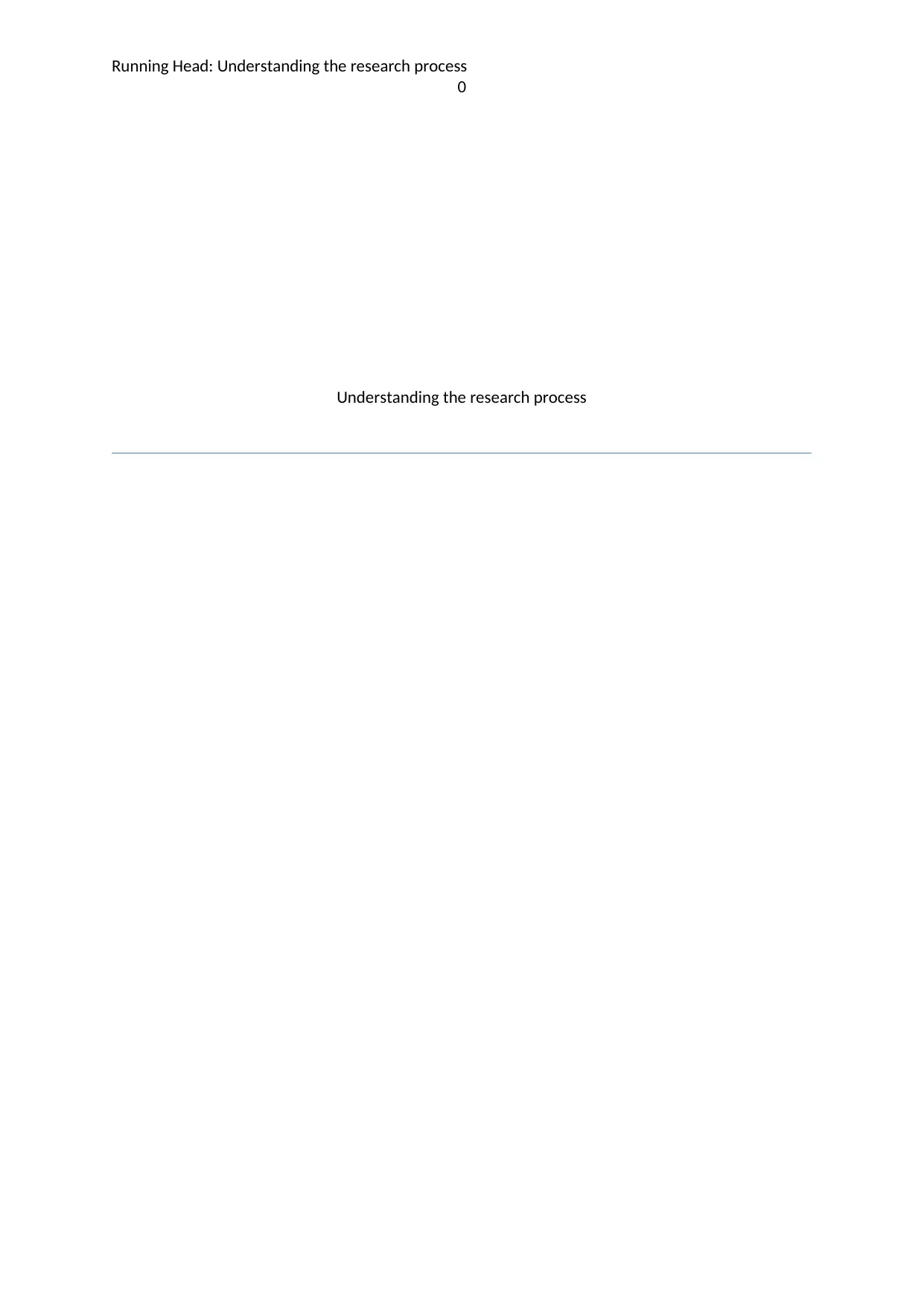
Running Head: Understanding the research process
0
Understanding the research process
0
Understanding the research process
Paraphrase This Document
Need a fresh take? Get an instant paraphrase of this document with our AI Paraphraser
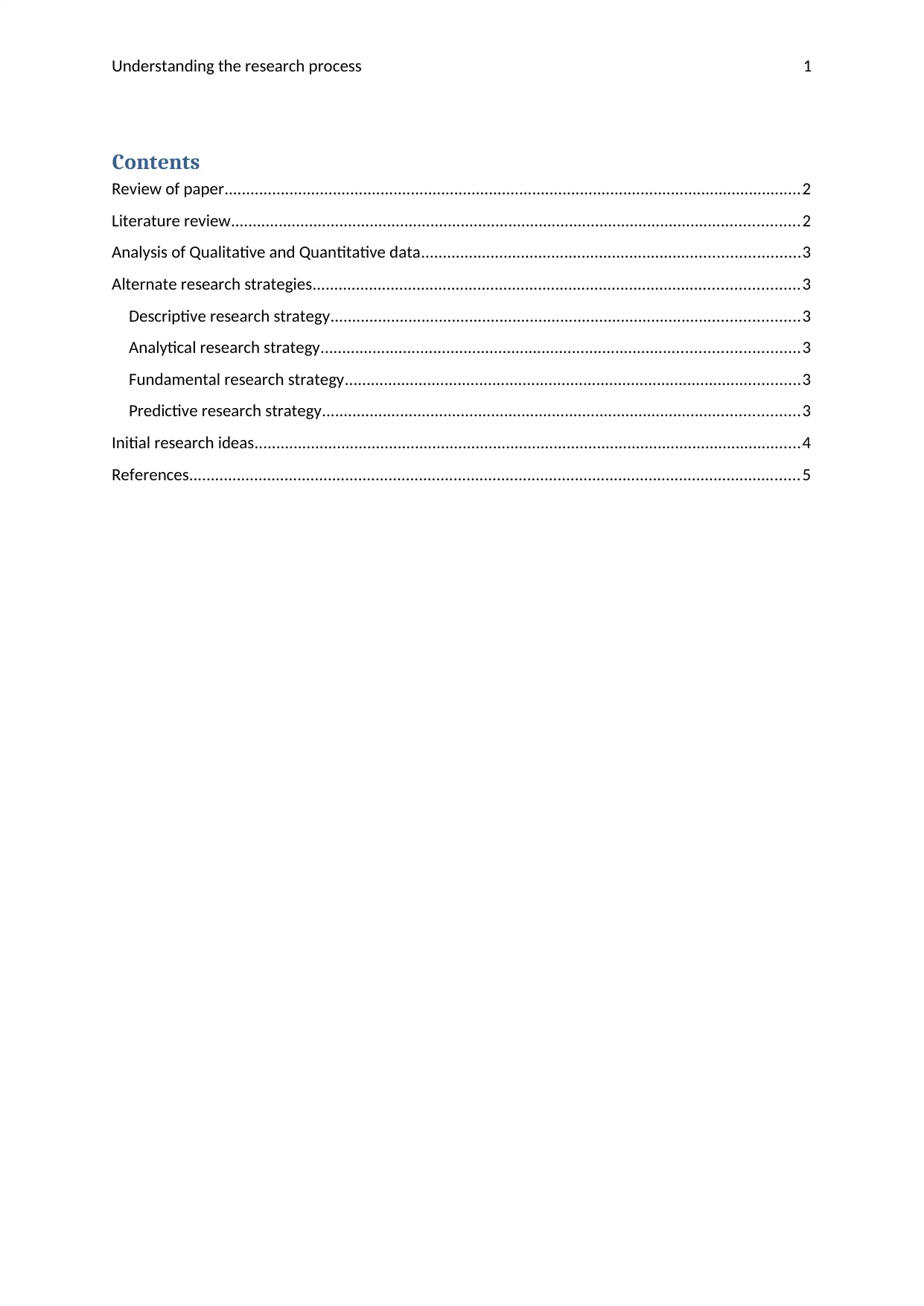
Understanding the research process 1
Contents
Review of paper.....................................................................................................................................2
Literature review...................................................................................................................................2
Analysis of Qualitative and Quantitative data.......................................................................................3
Alternate research strategies................................................................................................................3
Descriptive research strategy............................................................................................................3
Analytical research strategy..............................................................................................................3
Fundamental research strategy.........................................................................................................3
Predictive research strategy..............................................................................................................3
Initial research ideas..............................................................................................................................4
References.............................................................................................................................................5
Contents
Review of paper.....................................................................................................................................2
Literature review...................................................................................................................................2
Analysis of Qualitative and Quantitative data.......................................................................................3
Alternate research strategies................................................................................................................3
Descriptive research strategy............................................................................................................3
Analytical research strategy..............................................................................................................3
Fundamental research strategy.........................................................................................................3
Predictive research strategy..............................................................................................................3
Initial research ideas..............................................................................................................................4
References.............................................................................................................................................5
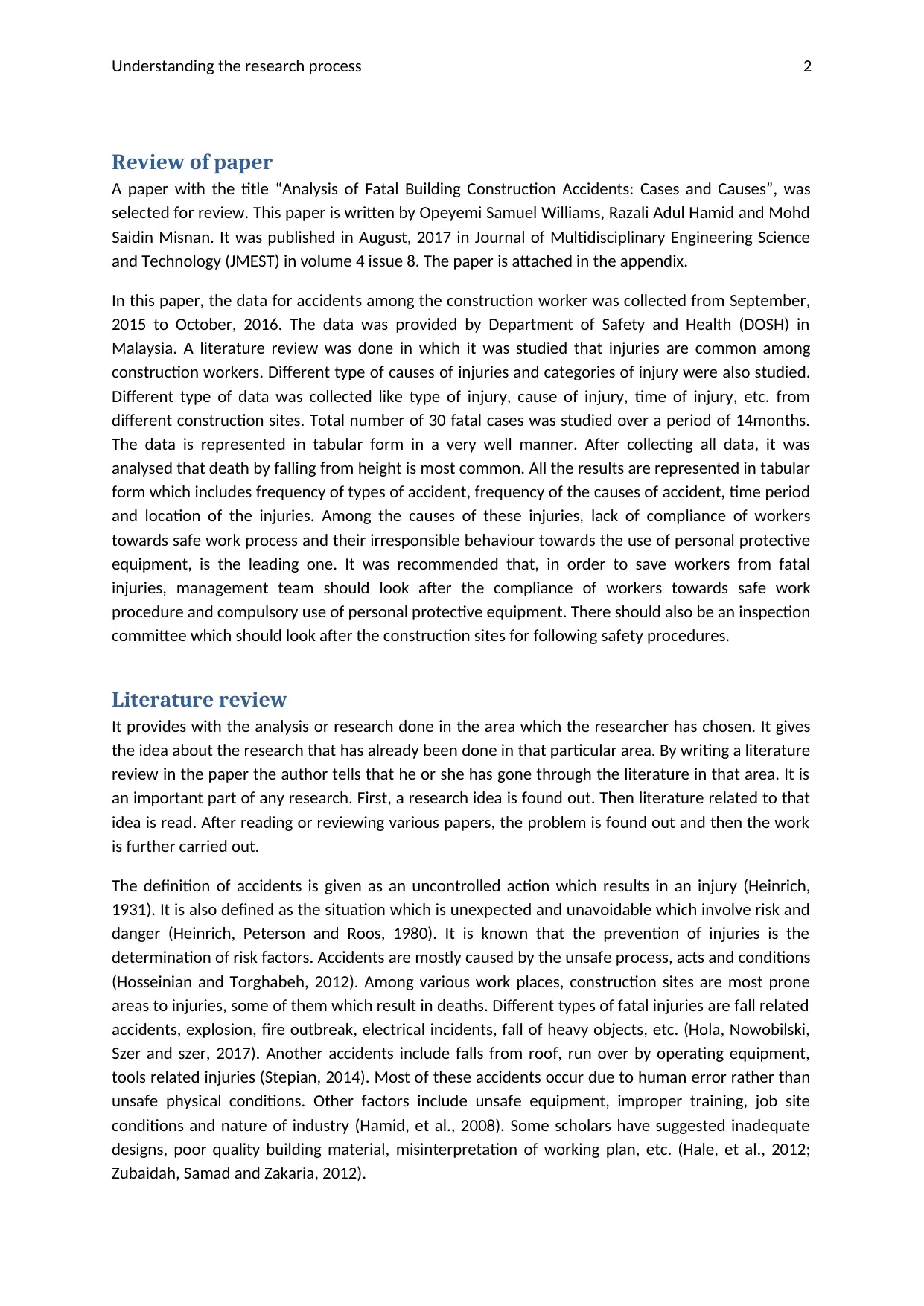
Understanding the research process 2
Review of paper
A paper with the title “Analysis of Fatal Building Construction Accidents: Cases and Causes”, was
selected for review. This paper is written by Opeyemi Samuel Williams, Razali Adul Hamid and Mohd
Saidin Misnan. It was published in August, 2017 in Journal of Multidisciplinary Engineering Science
and Technology (JMEST) in volume 4 issue 8. The paper is attached in the appendix.
In this paper, the data for accidents among the construction worker was collected from September,
2015 to October, 2016. The data was provided by Department of Safety and Health (DOSH) in
Malaysia. A literature review was done in which it was studied that injuries are common among
construction workers. Different type of causes of injuries and categories of injury were also studied.
Different type of data was collected like type of injury, cause of injury, time of injury, etc. from
different construction sites. Total number of 30 fatal cases was studied over a period of 14months.
The data is represented in tabular form in a very well manner. After collecting all data, it was
analysed that death by falling from height is most common. All the results are represented in tabular
form which includes frequency of types of accident, frequency of the causes of accident, time period
and location of the injuries. Among the causes of these injuries, lack of compliance of workers
towards safe work process and their irresponsible behaviour towards the use of personal protective
equipment, is the leading one. It was recommended that, in order to save workers from fatal
injuries, management team should look after the compliance of workers towards safe work
procedure and compulsory use of personal protective equipment. There should also be an inspection
committee which should look after the construction sites for following safety procedures.
Literature review
It provides with the analysis or research done in the area which the researcher has chosen. It gives
the idea about the research that has already been done in that particular area. By writing a literature
review in the paper the author tells that he or she has gone through the literature in that area. It is
an important part of any research. First, a research idea is found out. Then literature related to that
idea is read. After reading or reviewing various papers, the problem is found out and then the work
is further carried out.
The definition of accidents is given as an uncontrolled action which results in an injury (Heinrich,
1931). It is also defined as the situation which is unexpected and unavoidable which involve risk and
danger (Heinrich, Peterson and Roos, 1980). It is known that the prevention of injuries is the
determination of risk factors. Accidents are mostly caused by the unsafe process, acts and conditions
(Hosseinian and Torghabeh, 2012). Among various work places, construction sites are most prone
areas to injuries, some of them which result in deaths. Different types of fatal injuries are fall related
accidents, explosion, fire outbreak, electrical incidents, fall of heavy objects, etc. (Hola, Nowobilski,
Szer and szer, 2017). Another accidents include falls from roof, run over by operating equipment,
tools related injuries (Stepian, 2014). Most of these accidents occur due to human error rather than
unsafe physical conditions. Other factors include unsafe equipment, improper training, job site
conditions and nature of industry (Hamid, et al., 2008). Some scholars have suggested inadequate
designs, poor quality building material, misinterpretation of working plan, etc. (Hale, et al., 2012;
Zubaidah, Samad and Zakaria, 2012).
Review of paper
A paper with the title “Analysis of Fatal Building Construction Accidents: Cases and Causes”, was
selected for review. This paper is written by Opeyemi Samuel Williams, Razali Adul Hamid and Mohd
Saidin Misnan. It was published in August, 2017 in Journal of Multidisciplinary Engineering Science
and Technology (JMEST) in volume 4 issue 8. The paper is attached in the appendix.
In this paper, the data for accidents among the construction worker was collected from September,
2015 to October, 2016. The data was provided by Department of Safety and Health (DOSH) in
Malaysia. A literature review was done in which it was studied that injuries are common among
construction workers. Different type of causes of injuries and categories of injury were also studied.
Different type of data was collected like type of injury, cause of injury, time of injury, etc. from
different construction sites. Total number of 30 fatal cases was studied over a period of 14months.
The data is represented in tabular form in a very well manner. After collecting all data, it was
analysed that death by falling from height is most common. All the results are represented in tabular
form which includes frequency of types of accident, frequency of the causes of accident, time period
and location of the injuries. Among the causes of these injuries, lack of compliance of workers
towards safe work process and their irresponsible behaviour towards the use of personal protective
equipment, is the leading one. It was recommended that, in order to save workers from fatal
injuries, management team should look after the compliance of workers towards safe work
procedure and compulsory use of personal protective equipment. There should also be an inspection
committee which should look after the construction sites for following safety procedures.
Literature review
It provides with the analysis or research done in the area which the researcher has chosen. It gives
the idea about the research that has already been done in that particular area. By writing a literature
review in the paper the author tells that he or she has gone through the literature in that area. It is
an important part of any research. First, a research idea is found out. Then literature related to that
idea is read. After reading or reviewing various papers, the problem is found out and then the work
is further carried out.
The definition of accidents is given as an uncontrolled action which results in an injury (Heinrich,
1931). It is also defined as the situation which is unexpected and unavoidable which involve risk and
danger (Heinrich, Peterson and Roos, 1980). It is known that the prevention of injuries is the
determination of risk factors. Accidents are mostly caused by the unsafe process, acts and conditions
(Hosseinian and Torghabeh, 2012). Among various work places, construction sites are most prone
areas to injuries, some of them which result in deaths. Different types of fatal injuries are fall related
accidents, explosion, fire outbreak, electrical incidents, fall of heavy objects, etc. (Hola, Nowobilski,
Szer and szer, 2017). Another accidents include falls from roof, run over by operating equipment,
tools related injuries (Stepian, 2014). Most of these accidents occur due to human error rather than
unsafe physical conditions. Other factors include unsafe equipment, improper training, job site
conditions and nature of industry (Hamid, et al., 2008). Some scholars have suggested inadequate
designs, poor quality building material, misinterpretation of working plan, etc. (Hale, et al., 2012;
Zubaidah, Samad and Zakaria, 2012).
⊘ This is a preview!⊘
Do you want full access?
Subscribe today to unlock all pages.

Trusted by 1+ million students worldwide
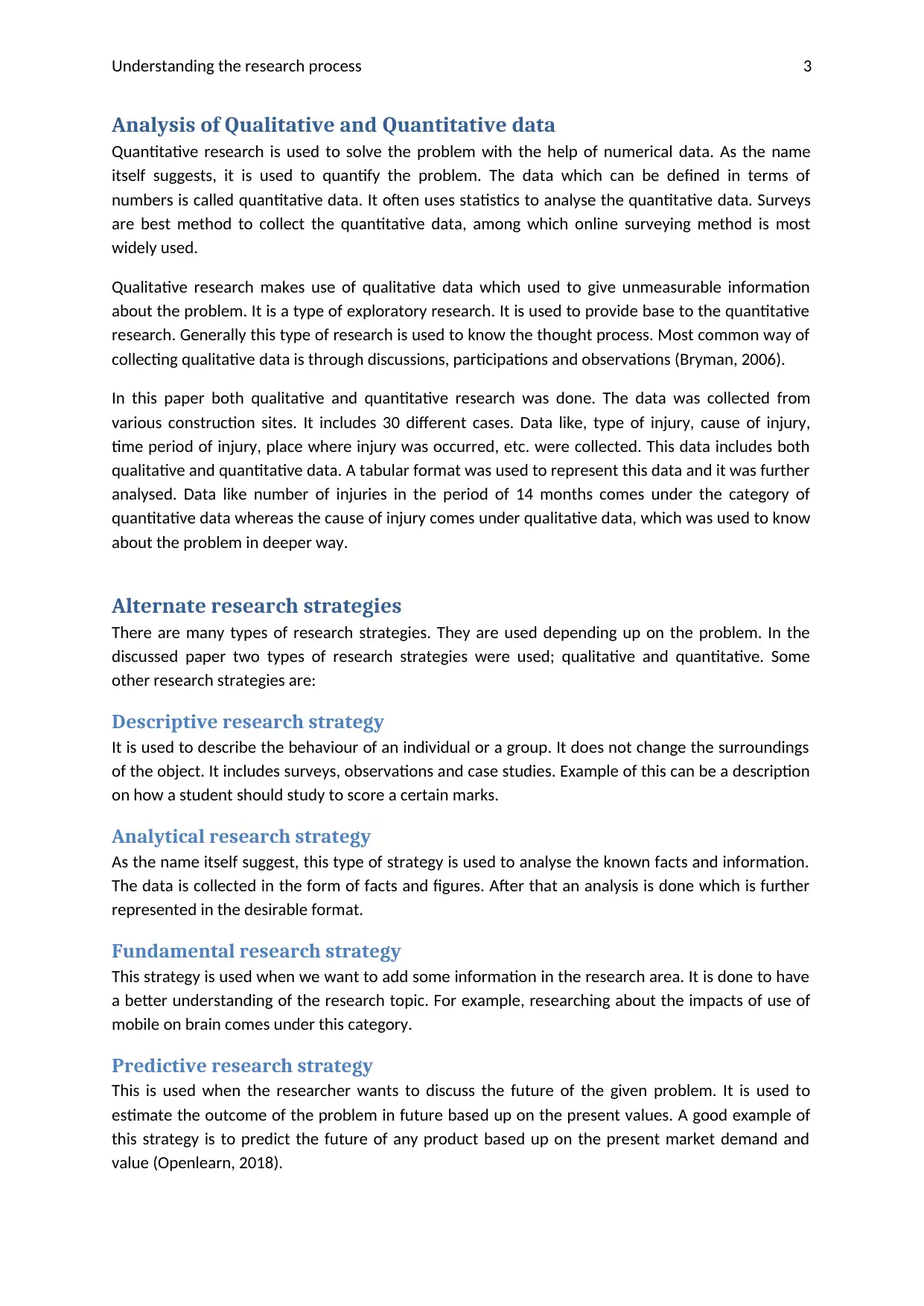
Understanding the research process 3
Analysis of Qualitative and Quantitative data
Quantitative research is used to solve the problem with the help of numerical data. As the name
itself suggests, it is used to quantify the problem. The data which can be defined in terms of
numbers is called quantitative data. It often uses statistics to analyse the quantitative data. Surveys
are best method to collect the quantitative data, among which online surveying method is most
widely used.
Qualitative research makes use of qualitative data which used to give unmeasurable information
about the problem. It is a type of exploratory research. It is used to provide base to the quantitative
research. Generally this type of research is used to know the thought process. Most common way of
collecting qualitative data is through discussions, participations and observations (Bryman, 2006).
In this paper both qualitative and quantitative research was done. The data was collected from
various construction sites. It includes 30 different cases. Data like, type of injury, cause of injury,
time period of injury, place where injury was occurred, etc. were collected. This data includes both
qualitative and quantitative data. A tabular format was used to represent this data and it was further
analysed. Data like number of injuries in the period of 14 months comes under the category of
quantitative data whereas the cause of injury comes under qualitative data, which was used to know
about the problem in deeper way.
Alternate research strategies
There are many types of research strategies. They are used depending up on the problem. In the
discussed paper two types of research strategies were used; qualitative and quantitative. Some
other research strategies are:
Descriptive research strategy
It is used to describe the behaviour of an individual or a group. It does not change the surroundings
of the object. It includes surveys, observations and case studies. Example of this can be a description
on how a student should study to score a certain marks.
Analytical research strategy
As the name itself suggest, this type of strategy is used to analyse the known facts and information.
The data is collected in the form of facts and figures. After that an analysis is done which is further
represented in the desirable format.
Fundamental research strategy
This strategy is used when we want to add some information in the research area. It is done to have
a better understanding of the research topic. For example, researching about the impacts of use of
mobile on brain comes under this category.
Predictive research strategy
This is used when the researcher wants to discuss the future of the given problem. It is used to
estimate the outcome of the problem in future based up on the present values. A good example of
this strategy is to predict the future of any product based up on the present market demand and
value (Openlearn, 2018).
Analysis of Qualitative and Quantitative data
Quantitative research is used to solve the problem with the help of numerical data. As the name
itself suggests, it is used to quantify the problem. The data which can be defined in terms of
numbers is called quantitative data. It often uses statistics to analyse the quantitative data. Surveys
are best method to collect the quantitative data, among which online surveying method is most
widely used.
Qualitative research makes use of qualitative data which used to give unmeasurable information
about the problem. It is a type of exploratory research. It is used to provide base to the quantitative
research. Generally this type of research is used to know the thought process. Most common way of
collecting qualitative data is through discussions, participations and observations (Bryman, 2006).
In this paper both qualitative and quantitative research was done. The data was collected from
various construction sites. It includes 30 different cases. Data like, type of injury, cause of injury,
time period of injury, place where injury was occurred, etc. were collected. This data includes both
qualitative and quantitative data. A tabular format was used to represent this data and it was further
analysed. Data like number of injuries in the period of 14 months comes under the category of
quantitative data whereas the cause of injury comes under qualitative data, which was used to know
about the problem in deeper way.
Alternate research strategies
There are many types of research strategies. They are used depending up on the problem. In the
discussed paper two types of research strategies were used; qualitative and quantitative. Some
other research strategies are:
Descriptive research strategy
It is used to describe the behaviour of an individual or a group. It does not change the surroundings
of the object. It includes surveys, observations and case studies. Example of this can be a description
on how a student should study to score a certain marks.
Analytical research strategy
As the name itself suggest, this type of strategy is used to analyse the known facts and information.
The data is collected in the form of facts and figures. After that an analysis is done which is further
represented in the desirable format.
Fundamental research strategy
This strategy is used when we want to add some information in the research area. It is done to have
a better understanding of the research topic. For example, researching about the impacts of use of
mobile on brain comes under this category.
Predictive research strategy
This is used when the researcher wants to discuss the future of the given problem. It is used to
estimate the outcome of the problem in future based up on the present values. A good example of
this strategy is to predict the future of any product based up on the present market demand and
value (Openlearn, 2018).
Paraphrase This Document
Need a fresh take? Get an instant paraphrase of this document with our AI Paraphraser
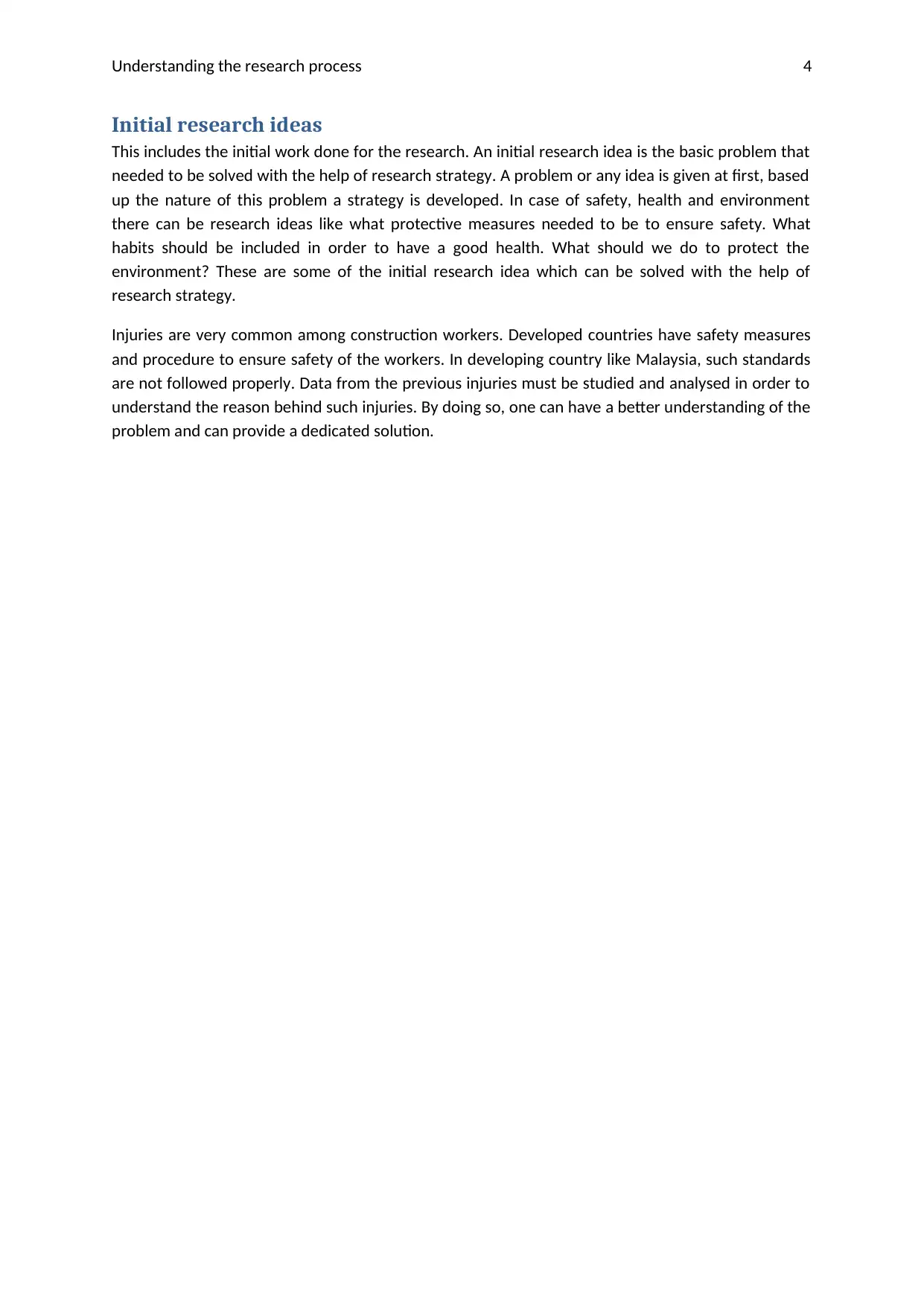
Understanding the research process 4
Initial research ideas
This includes the initial work done for the research. An initial research idea is the basic problem that
needed to be solved with the help of research strategy. A problem or any idea is given at first, based
up the nature of this problem a strategy is developed. In case of safety, health and environment
there can be research ideas like what protective measures needed to be to ensure safety. What
habits should be included in order to have a good health. What should we do to protect the
environment? These are some of the initial research idea which can be solved with the help of
research strategy.
Injuries are very common among construction workers. Developed countries have safety measures
and procedure to ensure safety of the workers. In developing country like Malaysia, such standards
are not followed properly. Data from the previous injuries must be studied and analysed in order to
understand the reason behind such injuries. By doing so, one can have a better understanding of the
problem and can provide a dedicated solution.
Initial research ideas
This includes the initial work done for the research. An initial research idea is the basic problem that
needed to be solved with the help of research strategy. A problem or any idea is given at first, based
up the nature of this problem a strategy is developed. In case of safety, health and environment
there can be research ideas like what protective measures needed to be to ensure safety. What
habits should be included in order to have a good health. What should we do to protect the
environment? These are some of the initial research idea which can be solved with the help of
research strategy.
Injuries are very common among construction workers. Developed countries have safety measures
and procedure to ensure safety of the workers. In developing country like Malaysia, such standards
are not followed properly. Data from the previous injuries must be studied and analysed in order to
understand the reason behind such injuries. By doing so, one can have a better understanding of the
problem and can provide a dedicated solution.
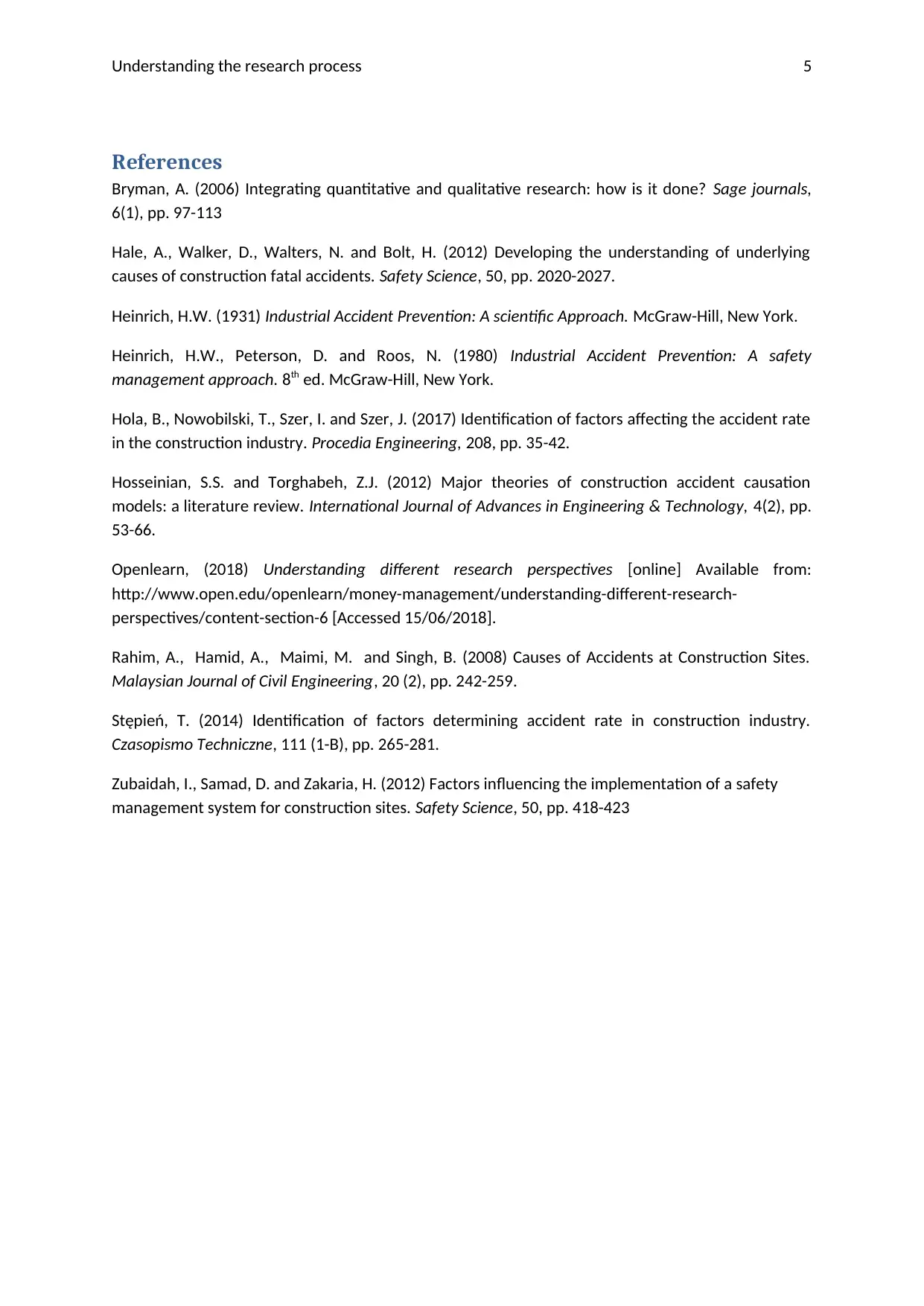
Understanding the research process 5
References
Bryman, A. (2006) Integrating quantitative and qualitative research: how is it done? Sage journals,
6(1), pp. 97-113
Hale, A., Walker, D., Walters, N. and Bolt, H. (2012) Developing the understanding of underlying
causes of construction fatal accidents. Safety Science, 50, pp. 2020-2027.
Heinrich, H.W. (1931) Industrial Accident Prevention: A scientific Approach. McGraw-Hill, New York.
Heinrich, H.W., Peterson, D. and Roos, N. (1980) Industrial Accident Prevention: A safety
management approach. 8th ed. McGraw-Hill, New York.
Hola, B., Nowobilski, T., Szer, I. and Szer, J. (2017) Identification of factors affecting the accident rate
in the construction industry. Procedia Engineering, 208, pp. 35-42.
Hosseinian, S.S. and Torghabeh, Z.J. (2012) Major theories of construction accident causation
models: a literature review. International Journal of Advances in Engineering & Technology, 4(2), pp.
53-66.
Openlearn, (2018) Understanding different research perspectives [online] Available from:
http://www.open.edu/openlearn/money-management/understanding-different-research-
perspectives/content-section-6 [Accessed 15/06/2018].
Rahim, A., Hamid, A., Maimi, M. and Singh, B. (2008) Causes of Accidents at Construction Sites.
Malaysian Journal of Civil Engineering, 20 (2), pp. 242-259.
Stępień, T. (2014) Identification of factors determining accident rate in construction industry.
Czasopismo Techniczne, 111 (1-B), pp. 265-281.
Zubaidah, I., Samad, D. and Zakaria, H. (2012) Factors influencing the implementation of a safety
management system for construction sites. Safety Science, 50, pp. 418-423
References
Bryman, A. (2006) Integrating quantitative and qualitative research: how is it done? Sage journals,
6(1), pp. 97-113
Hale, A., Walker, D., Walters, N. and Bolt, H. (2012) Developing the understanding of underlying
causes of construction fatal accidents. Safety Science, 50, pp. 2020-2027.
Heinrich, H.W. (1931) Industrial Accident Prevention: A scientific Approach. McGraw-Hill, New York.
Heinrich, H.W., Peterson, D. and Roos, N. (1980) Industrial Accident Prevention: A safety
management approach. 8th ed. McGraw-Hill, New York.
Hola, B., Nowobilski, T., Szer, I. and Szer, J. (2017) Identification of factors affecting the accident rate
in the construction industry. Procedia Engineering, 208, pp. 35-42.
Hosseinian, S.S. and Torghabeh, Z.J. (2012) Major theories of construction accident causation
models: a literature review. International Journal of Advances in Engineering & Technology, 4(2), pp.
53-66.
Openlearn, (2018) Understanding different research perspectives [online] Available from:
http://www.open.edu/openlearn/money-management/understanding-different-research-
perspectives/content-section-6 [Accessed 15/06/2018].
Rahim, A., Hamid, A., Maimi, M. and Singh, B. (2008) Causes of Accidents at Construction Sites.
Malaysian Journal of Civil Engineering, 20 (2), pp. 242-259.
Stępień, T. (2014) Identification of factors determining accident rate in construction industry.
Czasopismo Techniczne, 111 (1-B), pp. 265-281.
Zubaidah, I., Samad, D. and Zakaria, H. (2012) Factors influencing the implementation of a safety
management system for construction sites. Safety Science, 50, pp. 418-423
⊘ This is a preview!⊘
Do you want full access?
Subscribe today to unlock all pages.

Trusted by 1+ million students worldwide
1 out of 6
Related Documents
Your All-in-One AI-Powered Toolkit for Academic Success.
+13062052269
info@desklib.com
Available 24*7 on WhatsApp / Email
![[object Object]](/_next/static/media/star-bottom.7253800d.svg)
Unlock your academic potential
Copyright © 2020–2025 A2Z Services. All Rights Reserved. Developed and managed by ZUCOL.





